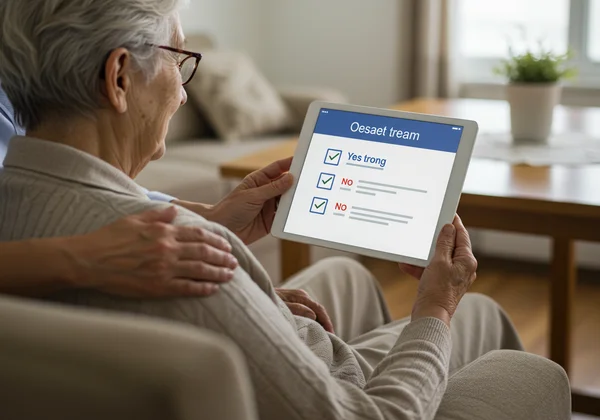Geriatric Depression Scale: A Caregiver's GDS Guide
As a caregiver, you are deeply invested in the health and happiness of your elderly loved one. You notice the small shifts in their mood and energy, and it's natural to worry when you see signs that they might be struggling emotionally. The Geriatric Depression Scale is an essential resource for you, offering a clear, simple way to gain insight into their well-being. It is a scientifically validated screening tool designed specifically to identify signs of depression in older adults. This guide will walk you through how to use it effectively and compassionately. If you're ready to gain a better understanding, you can start a free assessment anytime.
Understanding Elderly Depression Signs
One of the greatest challenges for any caregiver is recognizing the symptoms of depression, which can often be mistaken for other health issues or normal aspects of aging. Unlike the more overt sadness seen in younger individuals, depression in seniors can be subtle. It’s crucial to pay attention to persistent changes rather than isolated bad days.
Subtle Indicators of Depression in Seniors
Beyond obvious sadness, the emotional well-being of a senior can be affected in ways that are easy to miss. Look for patterns in the following areas:
-
Changes in Appetite and Sleep: A sudden loss of interest in food or, conversely, overeating can be a red flag. Similarly, watch for insomnia, excessive sleeping, or a disrupted sleep schedule.
-
Social Withdrawal: Has your loved one stopped participating in hobbies they once enjoyed? Do they make excuses to avoid seeing friends or family? This retreat from social life is a common symptom.
-
Unexplained Aches and Pains: Depression can manifest physically. If they complain of persistent headaches, stomach issues, or chronic pain that doesn't have a clear medical cause, it could be linked to their mental state.
-
Increased Irritability or Agitation: Instead of sadness, some seniors express depression through frustration, restlessness, or a short temper.

Differentiating Depression from Normal Aging Changes
Feeling down is commonly mistaken for a normal part of getting older. While life changes like retirement, loss of friends, or chronic illness can cause sadness, persistent depression is not. The key difference is duration and impact. A period of grief is natural, but a constant feeling of hopelessness that interferes with daily function is a sign of something more serious. Using a structured tool like the GDS helps separate temporary feelings from more concerning patterns that require attention. It provides a baseline for their mental health monitoring.
How Caregivers Can Use the Geriatric Depression Scale (GDS)
The GDS for family members is an invaluable ally. It transforms vague concerns into structured observations. Our platform provides a simple, confidential way to administer this test, helping you open up a vital conversation about mental health with your loved one. The process is straightforward and designed to be stress-free for both you and the senior in your care.
Preparing for a Sensitive GDS Conversation
Approaching the topic requires care and empathy. Choose a calm, comfortable time when you won't be interrupted. Frame the conversation around their overall health, not just their mood.
You might say something like, "I care about you so much, and I want to make sure we're looking after all aspects of your health. I found a simple questionnaire that helps us see how you've been feeling lately. Would you be willing to go through it with me?" Reassure them that it’s completely private and just a way to check in. Using our tool, you can help them explore the scale together in a supportive environment.
Administering the Free Online Geriatric Depression Scale
Our website makes this step incredibly easy. You can choose between the GDS Short Form (15 questions) for a quick screening or the GDS Long Form (30 questions) for a more comprehensive view. The questions are simple "yes" or "no" queries about their feelings over the past week.
Sit with your loved one and read the questions aloud, or let them complete it on their own if they are comfortable with a computer or tablet. The user-friendly design ensures it is accessible for seniors. Once completed, you will receive instant results, giving you an immediate, clear score to work with.

Interpreting Your Loved One's GDS Score
Receiving the score is the first step toward understanding. The geriatric depression scale scoring is designed to be straightforward, providing a numerical value that corresponds to a level of potential concern. Remember, this score is a starting point for a conversation, not a conclusion.
What Does a Normal Score on the Geriatric Depression Scale Mean?
For the widely used 15-item GDS, a score of 0-4 is generally considered within the normal range. This suggests that your loved one is likely not experiencing significant depressive symptoms. This can be reassuring news and provides a positive baseline for future check-ins. If you want to establish a baseline for your loved one, you can [try the GDS tes now.
When a High GDS Score Indicates Concern
A high score on the Geriatric Depression Scale, typically 5 or above on the 15-item scale, suggests the possibility of depression and indicates that a follow-up with a healthcare professional is highly recommended.
- 5-8 points: Suggests mild depression.
- 9-11 points: Suggests moderate depression.
- 12-15 points: Suggests severe depression. A high score is a signal to take action and seek professional guidance. It gives you concrete information to share with their doctor.
GDS: A Screening Tool, Not a Diagnostic Tool
The most critical point to remember is that the GDS is a highly effective screening instrument, but it is not a diagnostic tool. It cannot tell you with certainty that your loved one has clinical depression. Only a qualified doctor, psychiatrist, or psychologist can make a formal diagnosis after a thorough evaluation. The purpose of the GDS is to identify a potential risk so you know when it’s time to seek professional help.
Next Steps: Supporting Senior Mental Health
A GDS score, whether high or low, is a catalyst for action. Your role in helping to support senior mental health is pivotal. Armed with this information, you can take thoughtful and effective next steps to ensure your loved one receives the care and support they need.
Communicating GDS Results with Healthcare Professionals
When you speak with your loved one’s doctor, bring the GDS score with you. This gives the physician a valuable, objective piece of information. You can say, "We completed the Geriatric Depression Scale, and the score was [mention the score]. We're concerned and would like to discuss it." This is far more effective than saying, "I think Mom seems sad." It provides data that can guide the doctor’s assessment and lead to a more productive consultation.

Practical Ways to Offer Emotional Support at Home
Beyond professional medical advice, your daily support is essential. Here are a few ways you can help:
- Encourage Gentle Activity: Suggest a short walk, gardening, or another light activity they enjoy.
- Promote Social Connection: Arrange for calls or safe visits with friends and family. Loneliness is a major contributor to depression.
- Ensure Proper Nutrition: A balanced diet can have a significant impact on mood and energy levels.
- Listen Without Judgment: Sometimes, the best thing you can do is simply be there to listen. Let them express their feelings without trying to "fix" everything.
Empowering Caregivers: Your Role in Senior Mental Wellness
You are a vital advocate for your loved one's health. By using the Geriatric Depression Scale, you are taking a proactive, loving step to protect their emotional well-being. This tool empowers you to move from worry to action, providing the clarity needed to have meaningful conversations and seek the right help. You don't have to navigate these concerns alone.
We encourage you to use our free, confidential, and easy-to-use GDS tool as a first step. Take the first step today to gain valuable insight and support the mental wellness of the senior you care for.
Common Questions About the Geriatric Depression Scale
Is the Geriatric Depression Scale a diagnostic tool?
No, it is not. The GDS is a highly respected screening tool used to identify individuals who may be at risk for depression. A formal diagnosis can only be made by a qualified healthcare professional after a complete evaluation. The score from our confidential GDS screening should be used as a starting point for a conversation with a doctor.
Who can use the Geriatric Depression Scale?
The GDS is designed for older adults but is used by a wide range of people. This includes seniors conducting a self-assessment, family caregivers monitoring a loved one, and healthcare professionals like doctors and nurses who use it for clinical screening.
What does a high score on the Geriatric Depression Scale mean?
A high score (typically 5 or more on the 15-item version) indicates that there are significant depressive symptoms present. It serves as a strong signal that a professional consultation with a doctor or mental health specialist is necessary to determine the cause and discuss potential treatment or support options.
What is a normal score on the Geriatric Depression Scale?
A score between 0 and 4 on the 15-item GDS is generally considered to be in the normal range, suggesting that clinical depression is unlikely. However, any concerns about mood or behavior, regardless of the score, should be discussed with a healthcare provider.